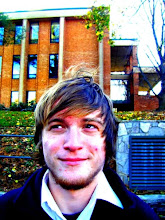For the uninitiated, a camera dolly is essentially a platform with wheels that you can sit a tripod on and roll the camera. However, I am going to take this a step further with a dolly track for this project. The track has several advantages over a standard dolly, the most obvious being that it...well, being a track, it will probably move in one direction. This also means that, because of the track, it can be setup on grass and other rough surfaces. It allows for very smooth, very fluid pullouts, pullins, and pans.
The typical low budget homemade dolly track is constructed of PVC pipe and skateboard wheels, and looks something like this:

Why is the Steadycam not applicable to this purpose? The Steadycam, for one, does not provide the smoothness or ease of use of a dolly track. It is more meant for tracking shots, where the camera follows someone around for an extended period of time and requires greater freedom of movement. The particular one we're using for this project, as I have mentioned, has the inverter bracket that is required for a key shot in the film.
So now I have explained what the dolly is for. But, if I may indulge, what is it...for?
There is a problem with stillness in film, especially low budget projects like ours. The nature of film as a medium is that it is not simply a set where things happen and we see it; it is about the way that we see these things happen. The best script in the world with scenes that bring you to tears with laughter or knock you to your knees in awe means absolutely nothing if you don't present it in a way that complements those words. Beauty requires beauty, and skill requires skill. The best films know how to balance this.
"Our Story" is a quiet, but fast-moving narrative. Therefore, many of the shots will have a gradual, subtle motion to them, frequently on the dolly. I call this "gentle kinetics," though I'm sure there's a term coined by directors who know far more than me and have master's degrees from UCLA.
I'm actually known at No Budget for my love of fast-moving handheld shots. You can see this in "Clocks" and in the fight scene at the end of "Stalin and Hitler: The Motion Picture," both of which were entirely shot by me. The rest of the group does typically prefer tripod shots, and this is not necessarily a bad thing. The problem with using frequent still shots, even with cuts, is that your film is static. The motion of the film needs to ebb and curve and balance and pool and overflow over mountaintops.
Granted, a lot of the work we've had thus far has lacked the emotional complexity of "Our Story." This is not a boastful statement; we made a comedy about dictators peeing on people and singing. Dramatic material has simply not been a part of our repertoire thus far. Therefore, exposition is perhaps less important in the comedy format, which is why the need for special devices like the dolly and steadycam hasn't really existed thus far in our 1.5-year existence.
"Our Story," however, will also have a great deal of still shots. They are good for providing exactly what stillness does: tension. Stasis, waiting, anticipation. Dolly shots keep the action from getting stale, and the full-blown high-speed shots are when the script is exploding with power and emotional intensity, when it is at its absolute rawest.
Of course, there's still no formula for this, much like for the writing process. In the end, you have to do what feels good. Stephen King said the problem with a lot of writers is that they write bullshit. Quite simply, they don't truly know what they write. Perhaps I should approach the camera in the same way?
Hmmm,
-JD
There are no updates for the Pre-Productive Organs today.


No comments:
Post a Comment